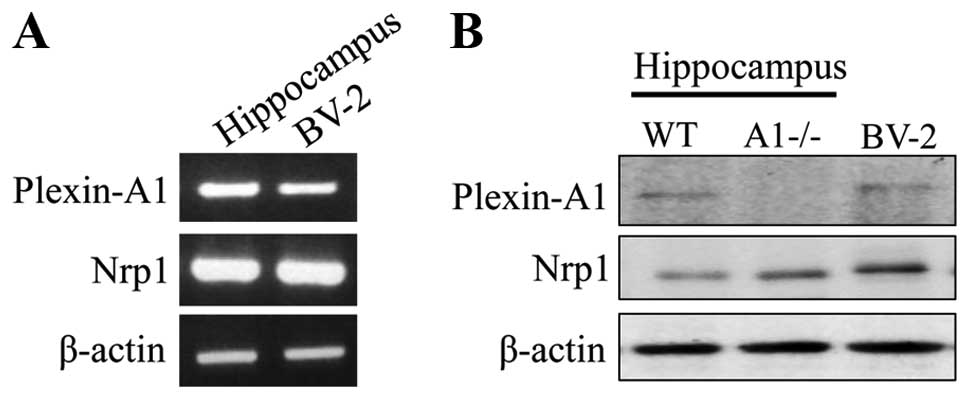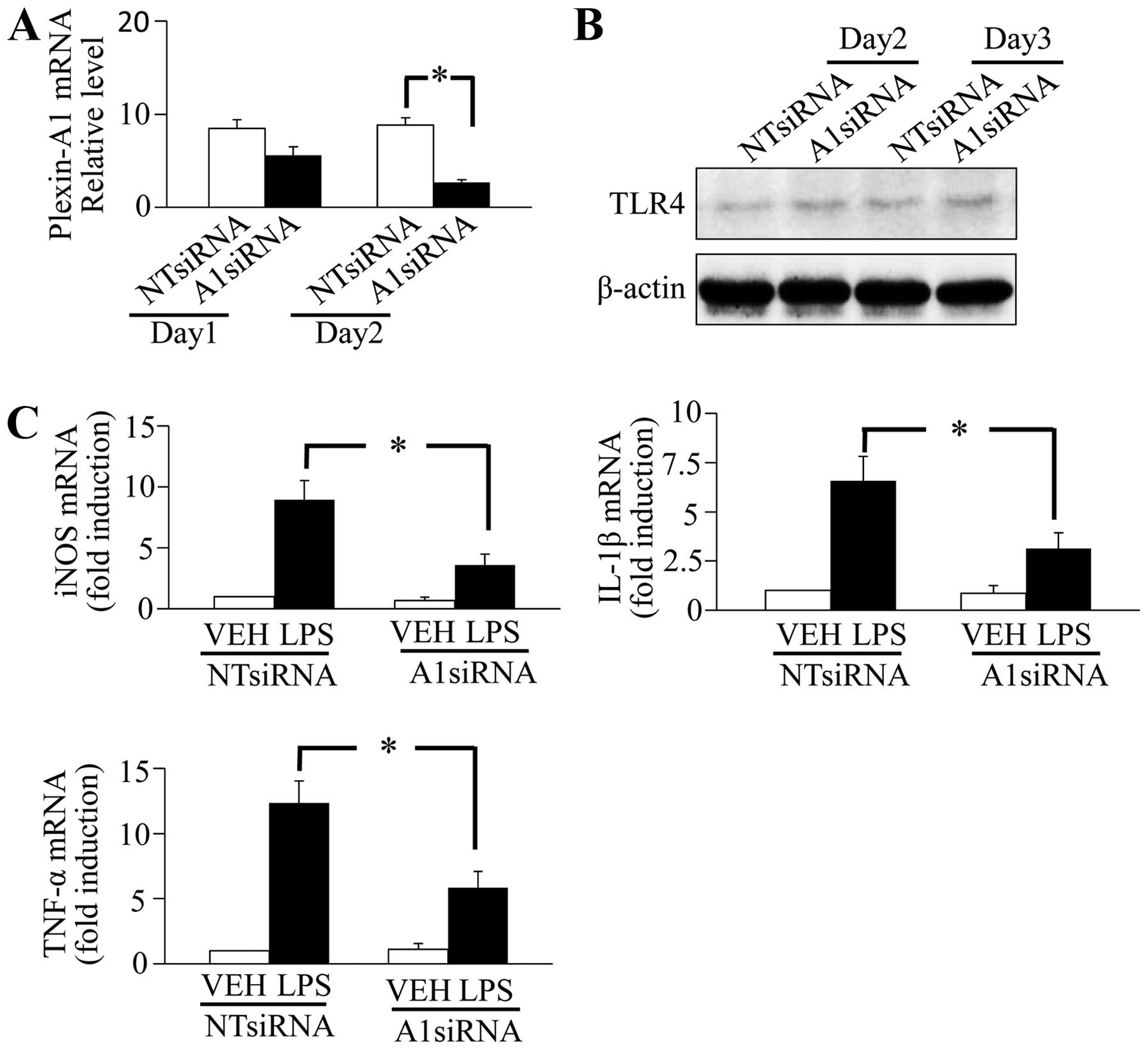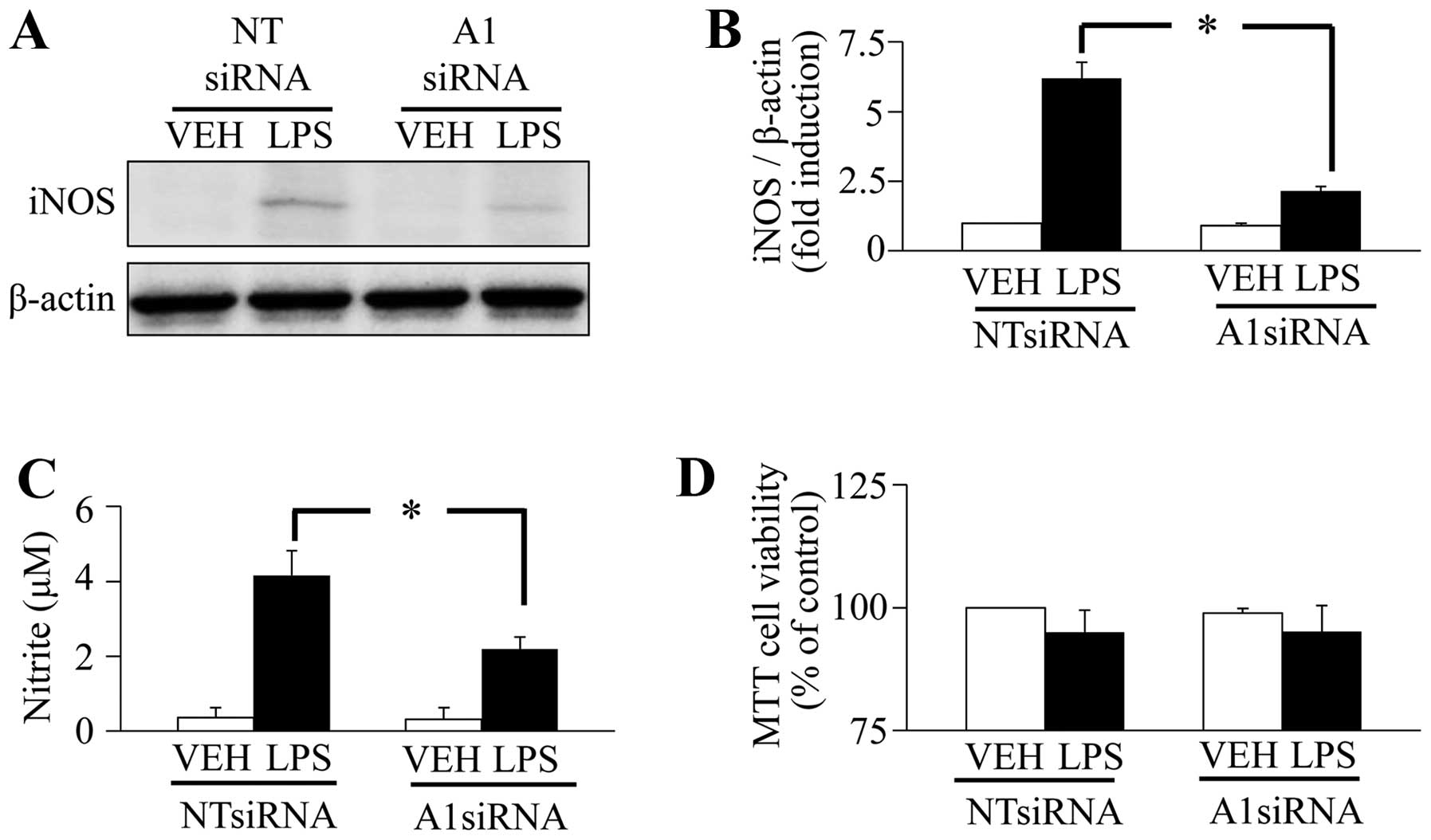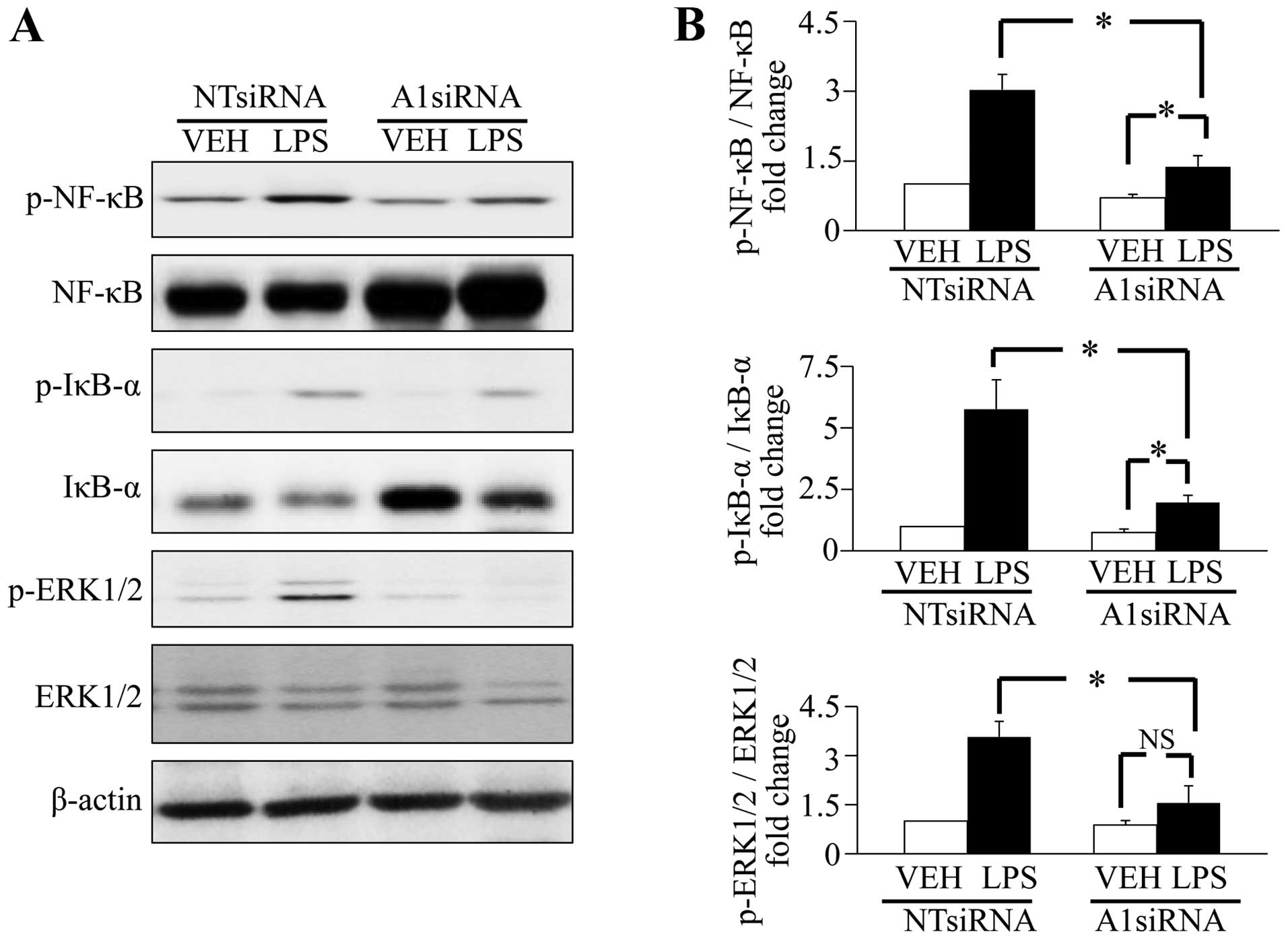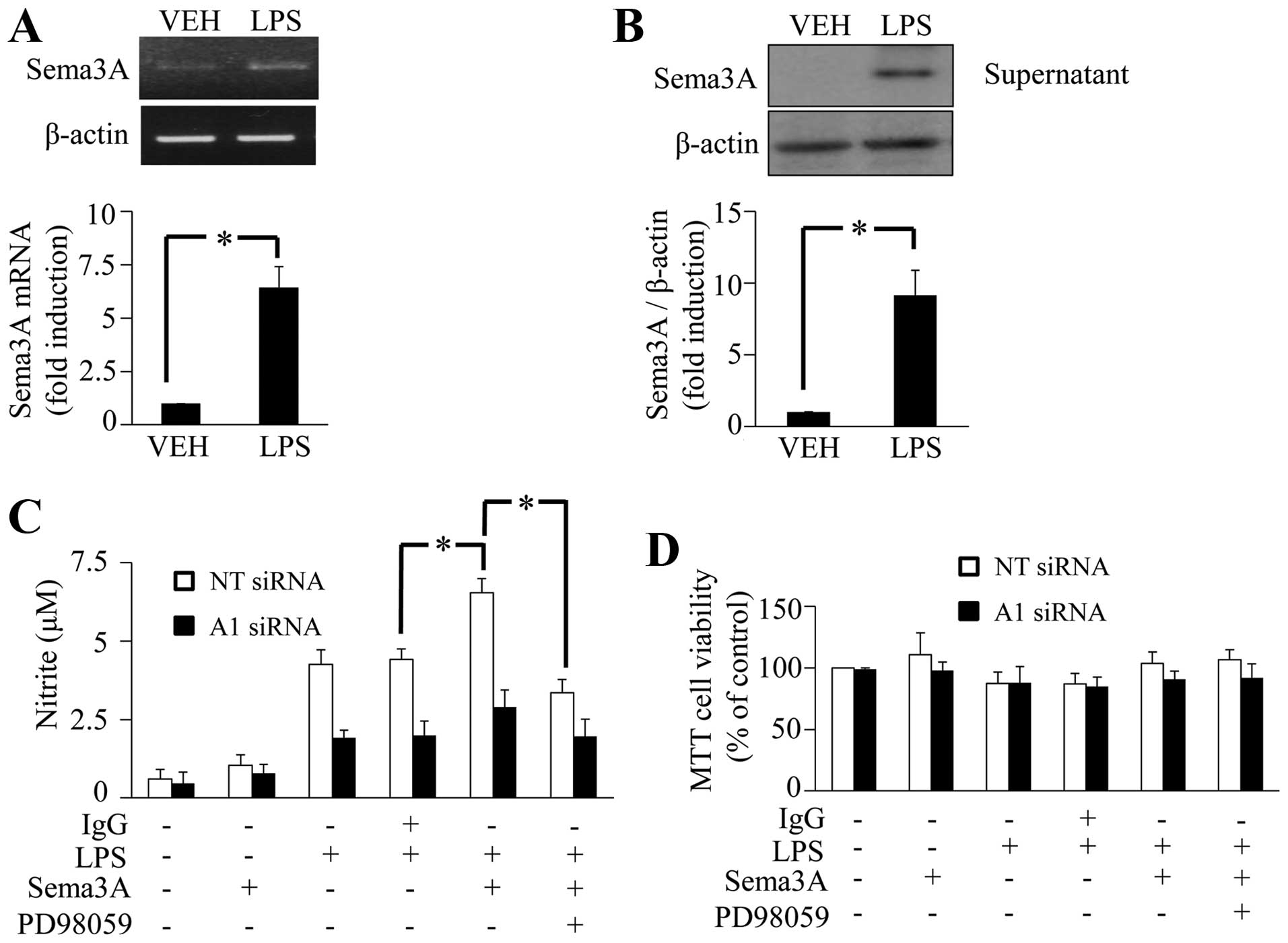|
1
|
Ransohoff RM and Perry VH: Microglial
physiology: unique stimuli, specialized responses. Annu Rev
Immunol. 27:119–145. 2009. View Article : Google Scholar : PubMed/NCBI
|
|
2
|
Heppner FL, Greter M, Marino D, et al:
Experimental autoimmune encephalomyelitis repressed by microglial
paralysis. Nat Med. 11:146–152. 2005. View
Article : Google Scholar : PubMed/NCBI
|
|
3
|
Jack C, Ruffini F, Bar-Or A and Antel JP:
Microglia and multiple sclerosis. J Neurosci Res. 81:363–373. 2005.
View Article : Google Scholar : PubMed/NCBI
|
|
4
|
Ponomarev ED, Shriver LP and Dittel BN:
CD40 expression by microglial cells is required for their
completion of a two-step activation process during central nervous
system autoimmune inflammation. J Immunol. 176:1402–1410. 2006.
View Article : Google Scholar
|
|
5
|
Lee SJ and Lee S: Toll-like receptors and
inflammation in the CNS. Curr Drug Targets Inflamm Allergy.
1:181–191. 2002. View Article : Google Scholar : PubMed/NCBI
|
|
6
|
Tran TS, Kolodkin AL and Bharadwaj R:
Semaphorin regulation of cellular morphology. Annu Rev Cell Dev
Biol. 23:263–292. 2007. View Article : Google Scholar : PubMed/NCBI
|
|
7
|
Gu Y, Filippi MD, Cancelas JA, et al:
Hematopoietic cell regulation by Rac1 and Rac2 guanosine
triphosphatases. Science. 302:445–449. 2003. View Article : Google Scholar : PubMed/NCBI
|
|
8
|
Toyofuku T, Zhang H, Kumanogoh A, et al:
Guidance of myocardial patterning in cardiac development by Sema6D
reverse signalling. Nat Cell Biol. 6:1204–1211. 2004. View Article : Google Scholar : PubMed/NCBI
|
|
9
|
Neufeld G and Kessler O: The semaphorins:
versatile regulators of tumour progression and tumour angiogenesis.
Nat Rev Cancer. 8:632–645. 2008. View
Article : Google Scholar : PubMed/NCBI
|
|
10
|
Suzuki K, Kumanogoh A and Kikutani H:
Semaphorins and their receptors in immune cell interactions. Nat
Immunol. 9:17–23. 2008. View
Article : Google Scholar : PubMed/NCBI
|
|
11
|
Walzer T, Galibert L and De Smedt T:
Dendritic cell function in mice lacking Plexin C1. Int Immunol.
17:943–950. 2005. View Article : Google Scholar : PubMed/NCBI
|
|
12
|
Choi YI, Duke-Cohan JS, Ahmed WB, et al:
PlexinD1 glycoprotein controls migration of positively selected
thymocytes into the medulla. Immunity. 29:888–898. 2008. View Article : Google Scholar : PubMed/NCBI
|
|
13
|
Yamamoto M, Suzuki K, Okuno T, et al:
Plexin-A4 negatively regulates T lymphocyte responses. Int Immunol.
20:413–420. 2008. View Article : Google Scholar
|
|
14
|
Wong AW, Brickey WJ, Taxman DJ, et al:
CIITA-regulated plexin-A1 affects T-cell-dendritic cell
interactions. Nat Immunol. 4:891–898. 2003. View Article : Google Scholar : PubMed/NCBI
|
|
15
|
Takegahara N, Takamatsu H, Toyofuku T, et
al: Plexin-A1 and its interaction with DAP12 in immune responses
and bone homeostasis. Nat Cell Biol. 8:615–622. 2006. View Article : Google Scholar : PubMed/NCBI
|
|
16
|
Wen H, Lei Y, Eun SY and Ting JP:
Plexin-A4-semaphorin 3A signaling is required for Toll-like
receptor- and sepsis-induced cytokine storm. J Exp Med.
207:2943–2957. 2010. View Article : Google Scholar : PubMed/NCBI
|
|
17
|
Okuno T, Nakatsuji Y, Moriya M, et al:
Roles of Sema4D-plexin-B1 interactions in the central nervous
system for pathogenesis of experimental autoimmune
encephalomyelitis. J Immunol. 184:1499–1506. 2010. View Article : Google Scholar : PubMed/NCBI
|
|
18
|
Ito T, Yoshida K, Negishi T, et al:
Plexin-A1is required for Toll-like receptor-mediated microglial
activation in the development of lipopolysaccharide-induced
encephalopathy. Int J Mol Med. 33:1122–1130. 2014.PubMed/NCBI
|
|
19
|
Blasi E, Barluzzi R, Bocchini V, Mazzolla
R and Bistoni F: Immortalization of murine microglial cells by a
v-raf/v-myc carrying retrovirus. J Neuroimmunol. 27:229–237. 1990.
View Article : Google Scholar : PubMed/NCBI
|
|
20
|
Zeng KW, Wang S, Dong X, Jiang Y and Tu
PF: Sesquiterpene dimer (DSF-52) from Artemisia argyi
inhibits microglia-mediated neuroinflammation via suppression of
NF-κB, JNK/p38 MAPKs and Jak2/Stat3 signaling pathways.
Phytomedicine. 21:298–306. 2013.PubMed/NCBI
|
|
21
|
Manivannan J, Tay SS, Ling EA and Dheen
ST: Dihydropyrimidinase-like 3 regulates the inflammatory response
of activated microglia. Neuroscience. 253:40–54. 2013. View Article : Google Scholar : PubMed/NCBI
|
|
22
|
Oh WJ, Jung U, Eom HS, Shin HJ and Park
HR: Inhibition of lipopolysaccharide-induced proinflammatory
responses by Buddleja officinalis extract in BV-2 microglial cells
via negative regulation of NF-κB and ERK1/2 signaling. Molecules.
18:9195–9206. 2013.PubMed/NCBI
|
|
23
|
Kaminska B: MAPK signalling pathways as
molecular targets for anti-inflammatory therapy - from molecular
mechanisms to therapeutic benefits. Biochim Biophys Acta.
1754:253–262. 2005. View Article : Google Scholar
|
|
24
|
Kaminska B, Gozdz A, Zawadzka M,
Ellert-Miklaszewska A and Lipko M: MAPK signal transduction
underlying brain inflammation and gliosis as therapeutic target.
Anat Rec (Hoboken). 292:1902–1913. 2009. View Article : Google Scholar : PubMed/NCBI
|
|
25
|
Koistinaho M and Koistinaho J: Role of p38
and p44/42 mitogen-activated protein kinases in microglia. Glia.
40:175–183. 2002. View Article : Google Scholar : PubMed/NCBI
|
|
26
|
Johnson GL and Lapadat R:
Mitogen-activated protein kinase pathways mediated by ERK, JNK, and
p38 protein kinases. Science. 298:1911–1912. 2002. View Article : Google Scholar : PubMed/NCBI
|
|
27
|
Bhat NR, Zhang P, Lee JC and Hogan EL:
Extracellular signal regulated kinase and p38 subgroups of
mitogen-activated protein kinases regulate inducible nitric oxide
synthase and tumor necrosis factor-α gene expression in
endotoxin-stimulated primary glial cultures. J Neurosci.
18:1633–1641. 1998.PubMed/NCBI
|
|
28
|
Bechara A, Nawabi H, Moret F, et al:
FAK-MAPK-dependent adhesion disassembly downstream of L1
contributes to semaphorin3A-induced collapse. EMBO J. 27:1549–1562.
2008. View Article : Google Scholar : PubMed/NCBI
|
|
29
|
Lerman O, Ben-Zvi A, Yagil Z and Behar O:
Semaphorin3A accelerates neuronal polarity in vitro and in its
absence the orientation of DRG neuronal polarity in vivo is
distorted. Mol Cell Neurosci. 36:222–234. 2007. View Article : Google Scholar : PubMed/NCBI
|
|
30
|
Bagnard D, Sainturet N, Meyronet D, et al:
Differential MAP kinases activation during semaphorin3A-induced
repulsion or apoptosis of neural progenitor cells. Mol Cell
Neurosci. 25:722–731. 2004. View Article : Google Scholar : PubMed/NCBI
|
|
31
|
Campbell DS and Holt CE: Apoptotic pathway
and MAPKs differentially regulate chemotropic responses of retinal
growth cones. Neuron. 37:939–952. 2003. View Article : Google Scholar : PubMed/NCBI
|
|
32
|
Kruger RP, Aurandt J and Guan KL:
Semaphorins command cells to move. Nat Rev Mol Cell Biol.
6:789–800. 2005. View
Article : Google Scholar : PubMed/NCBI
|
|
33
|
Adams RH, Lohrum M, Klostermann A, Betz H
and Püschel AW: The chemorepulsive activity of secreted semaphorins
is regulated by furin-dependent proteolytic processing. EMBO J.
16:6077–6086. 1997. View Article : Google Scholar : PubMed/NCBI
|
|
34
|
Catalano A, Caprari P, Moretti S, Faronato
M, Tamagnone L and Procopio A: Semaphorin-3A is expressed by tumor
cells and alters T-cell signal transduction and function. Blood.
107:3321–3329. 2006. View Article : Google Scholar : PubMed/NCBI
|
|
35
|
Lepelletier Y, Moura IC, Hadj-Slimane R,
et al: Immunosuppressive role of semaphorin-3A on T cell
proliferation is mediated by inhibition of actin cytoskeleton
reorganization. Eur J Immunol. 36:1782–1793. 2006. View Article : Google Scholar : PubMed/NCBI
|
|
36
|
Banks WA and Erickson MA: The blood-brain
barrier and immune function and dysfunction. Neurobiol Dis.
37:26–32. 2010. View Article : Google Scholar : PubMed/NCBI
|
|
37
|
Majed HH, Chandran S, Niclou SP, et al: A
novel role for Sema3A in neuroprotection from injury mediated by
activated microglia. J Neurosci. 26:1730–1738. 2006. View Article : Google Scholar : PubMed/NCBI
|



